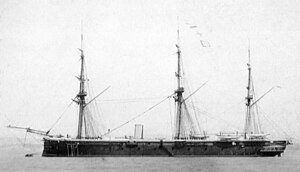 Defence as she appeared after 1866
| |
| Class overview | |
|---|---|
| Name | Defense-class ironclad |
| Builders | |
| Operators | |
| Preceded by | Warrior class |
| Succeeded by | Hector class |
| Built | 1859–1862 |
| In service | 1861–1935 |
| In commission | 1861–1885 |
| Completed | 2 |
| Scrapped | 2 |
| General characteristics | |
| Type | Armoured frigate |
| Displacement | 6,070–6,150 long tons (6,170–6,250 t) |
| Length | |
| Beam | 54 ft 2 in (16.5 m) |
| Draught |
|
| Installed power | |
| Propulsion | 1 shaft; 1 trunk steam engine |
| Sail plan | Barque rigged |
| Speed | 11 knots (20 km/h; 13 mph) |
| Range | 1,670 nmi (3,090 km; 1,920 mi) at 10 knots (19 km/h; 12 mph) |
| Complement | 460 |
| Armament |
|
| Armour | |
The Defence-class ironclads were a class of two warships built for the Royal Navy between 1859 and 1862. The ships were designed as armoured frigates[Note 1] in response to an invasion scare sparked by the launch of the French ironclad Gloire and her three sisters in 1858. They were initially armed with a mix of rifled breech-loading and muzzle-loading smoothbore guns, but the Armstrong breech-loading guns proved unreliable and were withdrawn from service after a few years.
Both ships were initially assigned to the Channel Squadron, but Resistance was transferred to the Mediterranean Squadron in 1864. The ships were rearmed in the late 1860s after the completion of their first commission. They alternated between assignments with the fleet and guardship duties with the First Reserve for the rest of their careers. Resistance was the first to be paid off in 1880 and was used as a target for gunnery and torpedo trials beginning in 1885. She was sold for ship breaking in 1898, but wrecked en route to the breaker's yard. Defence was paid off in 1885 and she became a stationary training ship in 1890 until she was sold for scrap in 1935.
Cite error: There are <ref group=Note> tags on this page, but the references will not show without a {{reflist|group=Note}} template (see the help page).